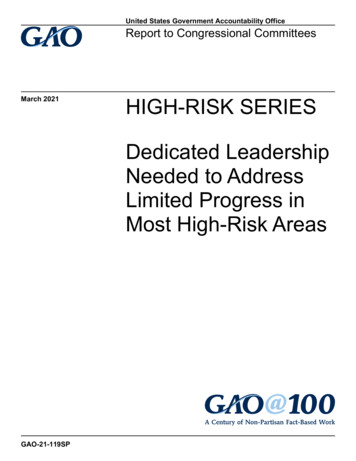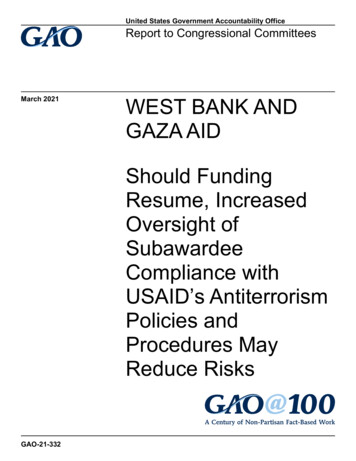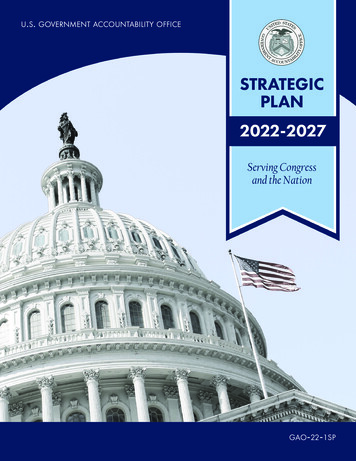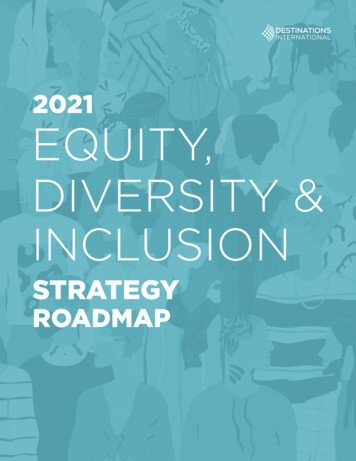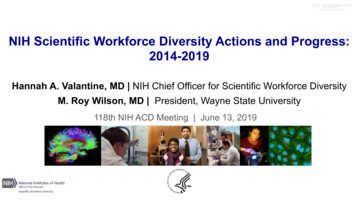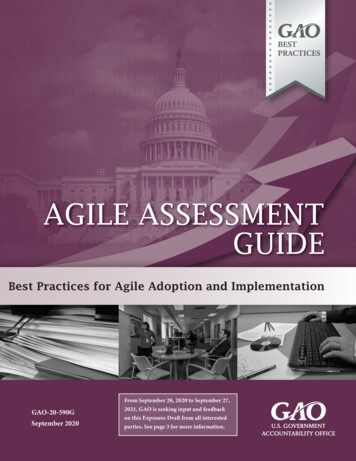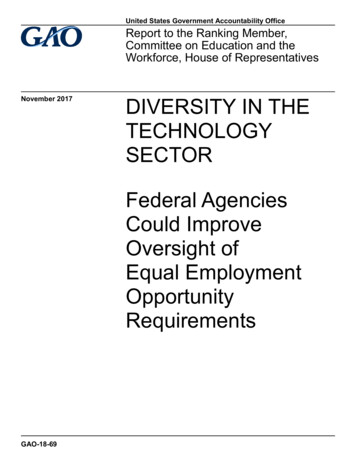
Transcription
United States Government Accountability OfficeReport to the Ranking Member,Committee on Education and theWorkforce, House of RepresentativesNovember 2017DIVERSITY IN THETECHNOLOGYSECTORFederal AgenciesCould ImproveOversight ofEqual EmploymentOpportunityRequirementsGAO-18-69
November 2017DIVERSITY IN THE TECHNOLOGY SECTORFederal Agencies Could Improve Oversightof Equal Employment Opportunity RequirementsHighlights of GAO-18-69, a report to theRanking Member, Committee on Educationand the Workforce, House of RepresentativesWhy GAO Did This StudyWhat GAO FoundTechnology companies are a majorsource of high-paying U.S. jobs, butsome have questioned the sector’scommitment to equal employmentopportunity. EEOC provides federaloversight of nondiscriminationrequirements by investigating chargesof discrimination, and OFCCP enforcesfederal contractors’ compliance withaffirmative action requirements. GAOwas asked to review workforce trendsin the technology sector and federaloversight.The estimated percentage of minority technology workers increased from 2005to 2015, but GAO found that no growth occurred for female and Black workers,whereas Asian and Hispanic workers made statistically significant increases (seefigure). Further, female, Black, and Hispanic workers remain a smaller proportionof the technology workforce—mathematics, computing, and engineeringoccupations—compared to their representation in the general workforce. Thesegroups have also been less represented among technology workers inside thetechnology sector than outside it. In contrast, Asian workers were morerepresented in these occupations than in the general workforce. Stakeholdersand researchers GAO interviewed identified several factors that may havecontributed to the lower representation of certain groups, such as fewer womenand minorities graduating with technical degrees and company hiring andretention practices.This report examines (1) trends in thegender, racial, and ethnic compositionof the technology sector workforce;and (2) EEOC and OFCCP oversightof technology companies’ compliancewith equal employment and affirmativeaction requirements. GAO analyzedworkforce data from the AmericanCommunity Survey for 2005-2015 andEEOC Employer Information Reportsfor 2007-2015, the latest data availableduring our analysis. GAO analyzedOFCCP data on complianceevaluations for fiscal years 2011-2016.GAO interviewed agency officials,researchers, and workforce, industry,and company representatives.What GAO RecommendsGAO makes 6 recommendations,including that EEOC develop a timelineto improve industry data collection andOFCCP take steps toward requiringmore specific minority placement goalsby contractors and assess key aspectsof its selection approach. EEOCneither agreed nor disagreed with itsrecommendation, and OFCCP statedthe need for regulatory change to alterplacement goal requirements. GAOcontinues to believe actions areneeded, as discussed in the report.View GAO-18-69. For more information,contact Cindy Brown Barnes at (202) 5127215 or brownbarnesc@gao.gov.Estimated Percentage of Technology Workers by Gender and Race/Ethnicity, 2005-2015Note: Changes from 2005 to 2015 were statistically significant at p-value 0.05 except for changesfor female, male, and Black workers. All population estimates have Relative Standard Errors of lessthan 7 percent. “Other” includes American Indian or Alaskan Native, and “Two or More Races”.White, Black, Asian, and “Other” categories include only non-Hispanic members.Both the U.S. Equal Employment Opportunity Commission (EEOC) and theDepartment of Labor’s Office of Federal Contract Compliance Programs(OFCCP) have taken steps to enforce equal employment and affirmative actionrequirements in the technology sector, but face limitations. While EEOC hasidentified barriers to recruitment and hiring in the technology sector as a strategicpriority, when EEOC conducts investigations, it does not systematically recordthe type of industry, therefore limiting sector-related analyses to help focus itsefforts. EEOC has plans to determine how to add missing industry codes but hasnot set a timeframe to do this. In addition, OFCCP’s regulations may hinder itsability to enforce contractors’ compliance because OFCCP directs contractors toset placement goals for all minorities as a group rather than for specificracial/ethnic groups. OFCCP also has not made changes to its establishmentbased approach to selecting entities for review in decades, even though changeshave occurred in how workplaces are structured. Without taking steps to addressthese issues, OFCCP may miss opportunities to hold contractors responsible forcomplying with affirmative action and nondiscrimination requirements.United States Government Accountability Office
ContentsLetter1BackgroundTechnology Workforce Grew between 2005-2015, but Women andSome Minority Groups Continued to be Less RepresentedEEOC and OFCCP Have Taken Steps to Oversee EqualEmployment Opportunity and Affirmative Action Requirements,but Face LimitationsConclusionsRecommendations for Executive ActionAgency Comments and Our Evaluation30454647Appendix IObjectives, Scope, and Methodology49Appendix IITechnology Occupations59Appendix IIINorth American Industry Classification System (NAICS) CodesIdentified as Technology-Related Industries61Percentage by Race/Ethnicity in Different Job Categories inCompanies Within and Outside the Technology Sector, 201563Appendix VComments from the Department of Labor64Appendix VIGAO Contact and Staff Acknowledgments70Appendix IV411TablesTable 1: Percentage of Women Within the Technology Sector inAll Job Categories, 2007, 2011, and 2015Table 2: Percentage of All Workers Within the Technology Sectorby Job Category and Race/Ethnicity, 2007, 2011 and2015Page i2123GAO-18-69 Diversity in the Technology Sector
Table 3: Top Industries Employing the Highest Concentration ofTechnology Workers, American Community Survey, 2014Table 4: Cross-walk of Bureau of Labor Statistics (BLS) StandardOccupational Classification (SOC) System Codes to U.S.Census Bureau Occupation CodesTable 5: List of North American Industry Classification System(NAICS) Codes Identified as Technology-relatedIndustriesTable 6: Percentage by Race/Ethnicity in Different Job Categoriesin Companies Within and Outside the Technology Sector,201551596163FiguresFigure 1: Top 10 Geographic Areas for Technology SectorEmployment in the United States, 2014Figure 2: Estimated Percentage of Workers in TechnologyWorkforce and General Workforce by Gender, 2005-2015Figure 3: Estimated Percentage of Workers in the TechnologyWorkforce and General Workforce by Race/Ethnicity,2005-2015Figure 4: Estimated Percentage of Technology Workforce andGeneral Workforce by Race/Ethnicity and Gender, 2015Figure 5: Estimated Percent of Technology Workers Within andOutside the Technology Sector by Race/Ethnicity andGender, 2015Figure 6: Percentage of Workers by Gender in Different JobCategories in Companies Within and Outside theTechnology Sector, 2015Figure 7: Percentage by Minority Status and Race/Ethnicity inDifferent Job Categories in Companies Within andOutside the Technology Sector, 2015Figure 8: Proportion of Bachelor’s and Master’s Degrees Awardedby Field and Gender of Recipient, 2014Figure 9: Proportion of Bachelor’s and Master’s Degree’s Awardedby Field and Race/Ethnicity, 2014Page ii51314151719222527GAO-18-69 Diversity in the Technology Sector
MSIPEDSMOUNAICSOFCCPS&PSOCSTEMaffirmative action programAmerican Community SurveyBureau of Labor StatisticsU.S. Department of LaborData Universal Numbering SystemEmployer Information ReportU.S. Equal Employment Opportunity CommissionFunctional Affirmative Action ProgramFederal Procurement Data System-Next GenerationIntegrated Mission SystemIntegrated Postsecondary Education Data Systemmemorandum of understandingNorth American Industry Classification SystemOffice of Federal Contract Compliance ProgramsStandard & Poor’sStandard Occupational ClassificationScience, technology, engineering, and mathematicsThis is a work of the U.S. government and is not subject to copyright protection in theUnited States. The published product may be reproduced and distributed in its entiretywithout further permission from GAO. However, because this work may containcopyrighted images or other material, permission from the copyright holder may benecessary if you wish to reproduce this material separately.Page iiiGAO-18-69 Diversity in the Technology Sector
Letter441 G St. N.W.Washington, DC 20548November 16, 2017The Honorable Robert C. “Bobby” ScottRanking MemberCommittee on Education and the WorkforceHouse of RepresentativesDear Mr. Scott:Since the 1990s, the technology sector has become a major source ofemployment in the United States, and the sector is projected to continueto grow and produce high-paying jobs. As the technology sector hasgrown, the nation’s overall workforce has become more diverse and thistrend is expected to continue into the future. Recently, media reports,technology workforce organizations, and policymakers have raisedquestions about diversity in the technology sector workforce and theextent to which companies are making changes to improve diversity andprevent discrimination. Diversity has been a focus not only because ofconcerns about equal access to these growing and high paying jobs, butbecause studies have associated a diversity of perspectives withenhanced innovation and other business advantages. Federal lawpromotes equal employment opportunity by prohibiting companies fromdiscriminating in employment on the basis of race and gender, amongother things, and generally requires companies contracting with thefederal government to comply with affirmative action and other equalemployment opportunity provisions. The U.S. Equal EmploymentOpportunity Commission (EEOC) and the U.S. Department of Labor’sOffice of Federal Contract Compliance Programs (OFCCP) are theprimary federal agencies that enforce these requirements.You asked us to review gender, ethnic, and racial diversity trends intechnology companies and federal oversight of antidiscrimination laws inthis sector. This report examines (1) the demographic trends in therepresentation of women and racial and ethnic groups in the technologysector for the last 10 years, and (2) the efforts by EEOC and OFCCP tooversee technology companies’ and technology contractors’ compliancewith equal employment opportunity and affirmative action requirements.There is no common definition of technology workers or which industriescomprise the technology sector. Therefore for this report, we definedtechnology workers as people who work in occupations in the fields ofcomputing, engineering, and mathematics. We defined the technologysector as a group of industries with the highest concentration ofPage 1GAO-18-69 Diversity in the Technology Sector
technology workers, such as computer systems design and softwarepublishing, which is an approach similar to what other federal agencieshave used recently to analyze trends within this sector. 1 To describe thedemographic trends within the technology workforce from 2005 through2015, we analyzed workforce data from the American Community Survey(ACS) administered by the U.S. Census Bureau and from the EEOC’sEmployer Information Reports (EEO-1).For this report, we used ACS data to estimate populations in technologyoccupations which we refer to as technology workers, or the technologyworkforce. We compared the technology workforce to the generalworkforce, which we defined as workers in all other occupations,excluding workers in technology occupations, as a benchmark tounderstand trends for the technology workforce in the context of overallworkforce trends. 2 In addition, we conducted further analysis of ACS datato compare technology workers within and outside the technology sector.Using EEO-1 data, we also analyzed workforce trends among similaroccupations in the workforces of companies within and outside thetechnology sector. Our analysis was not designed to determine thepresence or absence of discrimination.To understand diversity in academic preparation for technologyoccupations, we reviewed 2014 degree completion data from the NationalCenter for Educational Statistics’ Integrated Postsecondary EducationData System (IPEDS) as tabulated by the National Science Foundation. 3Using a variety of sources, such as academic research and interviewswith representatives from academia, we defined technology-related fields1We identified 15 industries with the highest concentration of technology workers usingCensus industry codes. The concentration of technology workers in these industriesranged from a high of 62.2 percent in the computer systems design and related servicesindustry to a low of 19.33 percent in the wired telecommunications carriers industry. Seeappendix I for more information regarding our industry selection, including the specificindustries we included. Appendix II provides a list of the specific occupations we includedin our analysis as technology occupations to identify the technology workforce. AppendixIII provides the North American Industry Classification System codes for the industries weidentified with the highest concentration of technology workers.2For this analysis, we excluded individuals in the Armed Forces and those not in the laborforce. We included individuals identified as 1) civilian employed, at work, 2) civilianemployed, with a job but not at work, and 3) unemployed.3National Science Foundation, National Center for Science and Engineering Statistics.Women, Minorities, and Persons with Disabilities in Science and Engineering: 2015.Special Report NSF 15-311. Arlington, VA.Page 2GAO-18-69 Diversity in the Technology Sector
as degree programs in computer science, engineering, and mathematics.Through a review of documentation, electronic testing, and/or interviewswith agency officials knowledgeable about the data, we found these datasufficiently reliable for our purposes.To review EEOC and OFCCP’s oversight efforts related to technologycompanies’ and federal technology contractors’ compliance with federalequal employment opportunity and affirmative action requirements, wereviewed relevant federal statutes, regulations, and agency policies andconducted interviews with agency officials. We analyzed OFCCP data onaffirmative action compliance evaluations from fiscal year 2011 through2016. We assessed the reliability of the data by reviewing agencydocumentation and interviewing agency officials, and we determined thatthe OFCCP data were sufficiently reliable for our purposes. 4Additionally, we interviewed academics and representatives fromworkforce and industry organizations that either promote diversity oradvocate for the technology sector, as well as representatives of eightinformation technology companies who work on diversity and inclusionand compliance issues, to obtain information about challenges andopportunities for diversity in the sector, and perspectives on federaloversight of antidiscrimination laws. 5 The views expressed by thecompanies’ representatives may not be representative of all technologycompanies on these issues. See appendix I for more information on ourmethodology.4We did not evaluate the agencies’ specific procedures for handling complaints orinvestigations. Also, our review was focused only on their activities with respect torace/ethnicity and gender. We previously reported on OFCCP’s oversight procedures inSeptember 2016. See GAO, Equal Employment Opportunity: Strengthening OversightCould Improve Federal Contractor Nondiscrimination Compliance, GAO-16-750(Washington, D.C.: September 22, 2016). We have also previously reported on EEOC’sprivate sector enforcement program. See GAO, Equal Employment OpportunityCommission: Sharing Promising Practices and Fully Implementing Strategic HumanCapital Planning Can Improve Management of Growing Workload, GAO-08-589(Washington, D.C.: June 23, 2008) and EEOC: Burgeoning Workload Calls for NewApproaches, GAO/T-HEHS-95-170 (Washington, D.C.: May 23, 1995).5The eight companies were among the top 67 information technology companies identifiedon the Standard & Poor’s 500 list of the nation’s leading companies. We refer to these 67companies as “leading technology companies” in this report. We identified for interviewsthe top companies from this list of information technology companies that were located inthe San Francisco Bay area and were also federal contractors at some point betweenfiscal year 2011 and 2016.Page 3GAO-18-69 Diversity in the Technology Sector
We conducted this performance audit from May 2016 to November 2017in accordance with generally accepted government auditing standards.Those standards require that we plan and perform the audit to obtainsufficient, appropriate evidence to provide a reasonable basis for ourfindings and conclusions based on our audit objectives. We believe thatthe evidence obtained provides a reasonable basis for our findings andconclusions based on our audit objectives.BackgroundTechnology SectorThe technology sector has major employment hubs across the country,including the San Francisco Bay area, the greater New York City region,and the Washington-Arlington-Alexandria region (see fig. 1). In addition,technology workers are employed at companies outside the technologysector, such as in the retail or financial services industries. 6 For example,a large retail company may require technology workers to create andmanage their online sales activities, but the company itself would beconsidered part of the retail industry.6Technology companies also include workers in occupations beyond those related tomathematics, computing, or engineering such as attorneys, human resource professionalsand sales support staff.Page 4GAO-18-69 Diversity in the Technology Sector
Figure 1: Top 10 Geographic Areas for Technology Sector Employment in the United States, 2014Note: For the graphic, we rounded to the nearest hundred. According to EEOC, EEO-1 Single,Headquarters, and Establishment Reports were used for this analysis.Page 5GAO-18-69 Diversity in the Technology Sector
Federal RequirementsRelated to EqualEmployment Opportunityand Affirmative ActionPrivate companies are generally prohibited by federal law fromdiscriminating in employment on the basis of race, color, religion, sex,national origin, age, and disability status. 7 Additionally, federal contractorsand subcontractors are generally required to take affirmative action toensure that all applicants and employees are treated without regard torace, sex, color, religion, national origin, sexual orientation, and genderidentity, and to employ or advance in employment qualified individualswith disabilities and qualified covered veterans. 8 EEOC is responsible forenforcement of federal antidiscrimination laws, and OFCCP enforcesaffirmative action and nondiscrimination requirements for federalcontractors. EEOC and OFCCP have some shared activities and haveestablished a memorandum of understanding (MOU) to minimize anyduplication of effort. For example, under the MOU, individual complaintsfiled with OFCCP alleging discrimination under Title VII are generally7Title VII of the Civil Rights Act of 1964 (Title VII) prohibits employers with 15 or moreemployees from discriminating in employment on the basis of race, color, religion, sex, ornational origin. 42 U.S.C. §§ 2000e(b), 2000e-2(a). The Age Discrimination inEmployment Act of 1967 prohibits employers from discriminating in employment on thebasis of age, defined as being age 40 and over. 29 U.S.C. §§ 623, 631(a). The Americanswith Disabilities Act of 1990 prohibits employers with 15 or more employees fromdiscriminating in employment on the basis of disability, among other things. 42 U.S.C. §§12111(5), 12112. Whether a specific employer would be a covered entity under thesestatutes would depend on meeting requirements unique to each statute, as well as agencyregulations and legal precedent.8Executive Order 11246 prohibits covered federal contractors—generally, holders offederal contracts and subcontracts of over 10,000—from discriminating in employmentdecisions on the basis of race, color, religion, sex, sexual orientation, gender identity, ornational origin. It also requires these contractors to take affirmative action to ensure thatequal employment opportunity is provided in employment without regard to theseprotected characteristics. Under OFCCP’s implementing regulations, non-constructioncontractors with contracts of 50,000 or more and 50 or more employees must developand maintain a written affirmative action program, including an affirmative action plan.Section 503 of the Rehabilitation Act of 1973 requires covered federal contractors andsubcontractors to take affirmative action to employ and advance in employment qualifiedindividuals with disabilities. 29 U.S.C. § 793. The Vietnam Era Veterans’ ReadjustmentAssistance Act of 1974 requires covered contractors to take affirmative action to employand advance in employment qualified covered veterans. 38 U.S.C. § 4212(a).Page 6GAO-18-69 Diversity in the Technology Sector
referred to EEOC. 9 In addition, on occasions when EEOC receives acomplaint not within its purview, such as cases that involve veteranstatus, but over which it believes OFCCP has jurisdiction, it will refer thecomplaint to OFCCP.U.S. Equal EmploymentOpportunity CommissionThe EEOC, created by Title VII of the Civil Rights Act of 1964, enforcesfederal laws that prohibit employment discrimination on the basis of race,sex, color, religion, national origin, age, and disability. 10 As the nation’sprimary enforcer of antidiscrimination laws, EEOC investigates charges ofemployment discrimination from the public, litigates major cases, andconducts outreach to prevent discrimination by educating employers andworkers. In fiscal year 2016, EEOC received about 91,500 charges,secured more than 482 million for victims of discrimination, and filed 114lawsuits. 11According to EEOC, many states, counties, cities, and towns have theirown laws prohibiting discrimination, usually similar to those EEOCenforces, as well as agencies responsible for enforcing those laws, calledFair Employment Practices Agencies. However, in some cases, theseagencies enforce laws that offer greater protection to workers. Anindividual can file a charge with either the EEOC or with a FairEmployment Practices Agency. When an individual initially files with aFair Employment Practices Agency that has a worksharing agreementwith the EEOC, and the allegation is covered by a law enforced by theEEOC, the Fair Employment Practices Agency will dual file the chargewith EEOC (meaning EEOC will receive a copy of the charge), but willusually retain the charge for processing. If the charge is initially filed with9Under the MOU, all complaints of employment discrimination filed with OFCCP alleging aTitle VII basis (race, color, religion, sex, national origin, or retaliation) shall be received ascomplaints simultaneously dual-filed under Title VII. OFCCP acts as EEOC’s agent for thepurposes of receiving the Title VII component of these complaints. When OFCCP receivessuch a complaint and determines that the employer is not a federal contractor subject toExecutive Order 11246, it shall transfer the complaint to EEOC. OFCCP will retain,investigate, process, and resolve complaints alleging discrimination of a systemic or classnature on a Title VII basis in dual-filed complaints. Under the MOU, OFCCP can alsoretain certain individual complaints so as to avoid duplication and ensure effective lawenforcement. See Coordination of Functions; Memorandum of Understanding, 76 Fed.Reg. 71,029 (Nov. 16, 2011).10EEOC enforces Title VII of the Civil Rights Act of 1964, the Age Discrimination inEmployment Act of 1967, and Titles I and V of the Americans with Disabilities Act of 1990,among others.11EEOC reported it resolved 97,443 charges and 139 lawsuits in fiscal year 2016.Page 7GAO-18-69 Diversity in the Technology Sector
EEOC and the charge is also covered by state or local law, EEOC dualfiles the charge with the state or local Fair Employment Practices Agency(meaning the Fair Employment Practices Agency will receive a copy ofthe charge), but EEOC ordinarily retains the charge for processing.EEOC also pursues a limited number of cases each year designed tocombat systemic discrimination, defined by the agency as patterns orpractices where the alleged discrimination presented by a complainanthas a broad impact on an industry, profession, company, or geographiclocation. EEOC can also initiate a systemic investigation under Title VIIwith the approval of an EEOC commissioner, called a “commissionercharge”, provided the commissioner finds there is a reasonable basis forthe investigation. 12 In addition, EEOC district directors can approvesystemic investigations, called “directed investigations” which are initiatedby EEOC field office directors under the Age Discrimination inEmployment Act and the Equal Pay Act. 13Under Title VII, EEOC generally requires that large employers and nonexempt federal contractors file Employer Information Reports (EEO-1reports) annually, 14 which collect employees’ demographic data bybusiness location on sex, race, and ethnic group for 10 occupational jobcategories. 15 According to EEOC documentation, EEO-1 data are used ininvestigations of Title VII violations, litigation, research, comparativeanalyses, class action suits, and affirmative action plans.Office of Federal ContractCompliance ProgramsThe OFCCP is responsible for ensuring that the nearly 200,000 federalcontractor establishments comply with federal nondiscrimination andaffirmative action requirements. Under Executive Order 11246 and otherfederal laws and regulations, covered federal contractors and1242 U.S.C. § 2000e- 5(b), 29 C.F.R. § 1601.11.1329 U.S.C. § 621 et seq., 29 U.S.C. § 206(d).14Private employers with 100 or more employees and all non-exempt federal primecontractors or first-tier subcontractors who have 50 or more employees and have a federalcontract, subcontract or purchase order of 50,000 or more are required to file an EEO-1report for each applicable establishment. EEOC collects these data under the authority ofTitle VII of the Civil Rights Act of 1964, as amended, and its implementing regulations. 42U.S.C. § 2000e-8(c); 29 C.F.R. pt. 1602.15The 10 different job categories include (1) Executive/Senior Level Officials andManagers, (2) First/Mid Level Officials and Managers, (3) Professionals, (4) Technicians,(5) Sales Workers, (6) Administrative Support Workers, (7) Craft Workers, (8) Operatives,(9) Laborers and Helpers, and (10) Service Workers.Page 8GAO-18-69 Diversity in the Technology Sector
subcontractors are prohibited from discriminating in employment on thebasis of race, color, religion, sex, sexual orientation, gender identity, ornational origin and are required to take affirmative action to help ensurethat all applicants and employees are treated without regard to thesefactors. 16 In general, OFCCP’s regulations require covered contractors tocomply with certain recordkeeping and reporting requirements, andprovide for enforcement procedures such as compliance evaluations andcomplaint investigations to assist OFCCP in ensuring federal contractorcompliance with these regulations.Among other provisions, OFCCP’s regulations generally require thatcovered contractors prepare and maintain an affirmative action program(AAP). 17 Under OFCCP’s regulations, an AAP is a management tool thatis designed to ensure equal employment opportunity, with an underlyingpremise that the gender, racial, and ethnic makeup of a contractor’sworkforce should be representative of the labor pools from which thecontractor recruits and selects. 18 Companies must create an AAP foreach business establishment—generally, a physical facility or unit thatproduces the goods or services, such as a factory, office, or store for thefederal contractor. 19 An AAP will also include any practical steps toaddress underrepresentation of women and minorities, such asexpanding employment opportunities to underrepresented groups.Covered contractors must also comply with certain recordkeeping16In 1965, President Johnson issued Executive Order 11246, which initially prohibitedcontractors from discriminating in employment on the basis of race, color, religion, ornational origin, and has since been amended to also cover sex, sexual orientation, andgender identity. OFCCP was established in 1965. OFCCP also enforces Section 503 ofthe Rehabilitation Act of 1973 and the Vietnam Era Veterans’ Readjustment AssistanceAct of 1974, all as amended, which apply to federal contractors and subcontractors if theymeet specific criteria, including contract dollar amount and employee count thresholds.However, OFCCP’s enforcement of these statutes regarding disabilities and veterans isoutside the scope of this review.17Generally, non-construction contractors that have 50 or more employees and a contractabove 50,000 amount are required to prepare an AAP within 120 days of thecommencement of the contract, and annually update the AAP. See generally 41 C.F.R. §§60-2.1 to 60-2.35.1841 C.F.R. § 60-2.10(a)(1).1941 C.F.R. § 60-2.1(b). A contractor must develop and maintain a written AAP for each ofits establishments if it has 50 or more employees.Page 9GAO-18-69 Diversity in the Technology Sector
requirements, including records pertaining to hiring, promotion, lay off ortermination, rates of pay, and applications, among other records. 20OFCCP’s enforcement program represents the majority of the agency’sactivity and is carried out primarily by using compliance officers, whoevaluate contractors’ compliance with various requirements, according toagency officials. In addition to conductin
commitment to equal employment opportunity. EEOC provides federal oversight of nondiscrimination requirements by investigating charges of discrimination, and OFCCP enforces federal contractors' compliance with affirmative action requirements. GAO was asked to review workforce trends in the technology sector and federal oversight.
